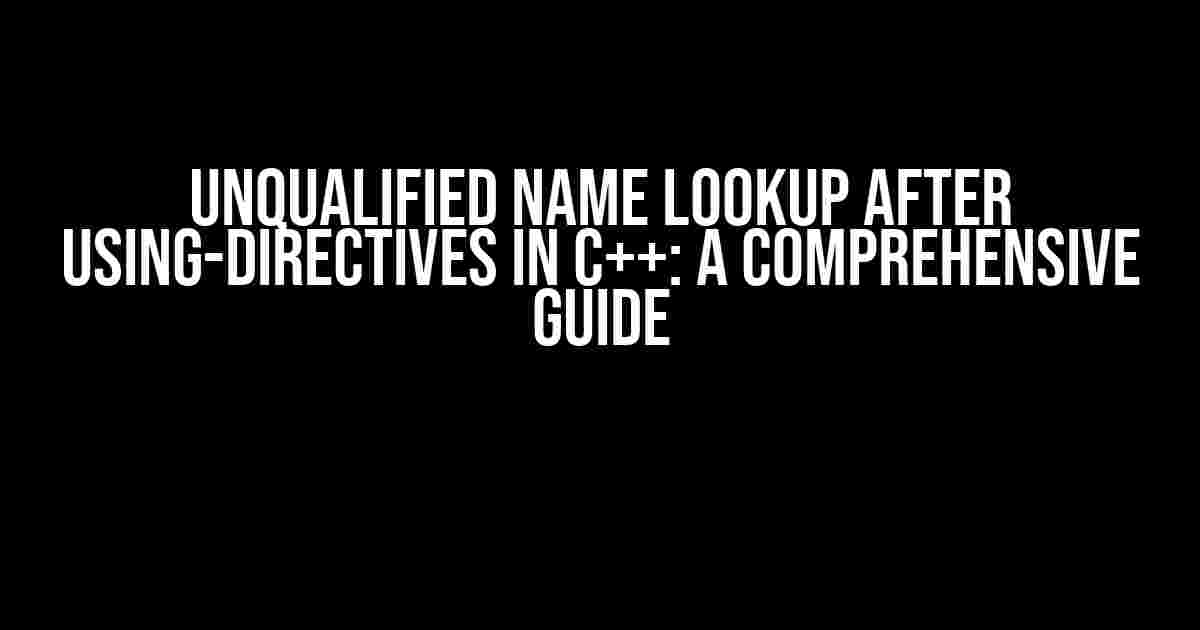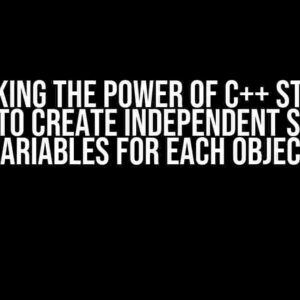When it comes to C++ programming, name lookup is a crucial concept that every developer should be familiar with. However, things can get a bit tricky when using-directives come into play. In this article, we’ll delve into the world of unqualified name lookup after using-directives in C++ and explore the ins and outs of this fascinating topic.
What is Unqualified Name Lookup?
Before we dive into the specifics of using-directives, let’s take a step back and understand what unqualified name lookup is. In C++, when you use an identifier (such as a variable, function, or class) without specifying its namespace or class, the compiler performs an unqualified name lookup to resolve the identifier.
For example, consider the following code snippet:
void foo() {
std::cout << "Hello, World!" << std::endl;
}
In this example, the identifier std::cout is qualified with the namespace std. However, what if we wanted to use the cout identifier without specifying the namespace? That’s where unqualified name lookup comes in.
What are Using-Directives?
Using-directives are a way to bring names from a namespace into the current scope, making them available for unqualified use. A using-directive is typically used to import entire namespaces or specific identifiers from a namespace.
For example:
using namespace std;
This using-directive brings all the names from the std namespace into the current scope, allowing us to use them without qualifying them with the namespace.
Unqualified Name Lookup after Using-Directives
Now that we’ve covered the basics of unqualified name lookup and using-directives, let’s explore what happens when we combine the two. When a using-directive is used, it affects the unqualified name lookup process in several ways.
Lookup Order
When the compiler encounters an unqualified identifier, it performs a lookup in the following order:
- The current scope (including any using-directives)
- The surrounding scopes (including any using-directives)
- The global scope
This means that if a using-directive is used to bring a name from a namespace into the current scope, the compiler will first look for the identifier in the current scope before moving on to the surrounding scopes and finally the global scope.
Ambiguity Resolution
When multiple using-directives are used, ambiguity can arise if the same identifier is defined in multiple namespaces. In such cases, the compiler will issue an error if it cannot resolve the ambiguity.
For example:
namespace A {
void foo() {}
}
namespace B {
void foo() {}
}
using namespace A;
using namespace B;
void bar() {
foo(); // Error: ambiguous
}
In this example, the compiler cannot resolve the ambiguity between the foo() functions from namespaces A and B. To avoid such issues, it’s essential to use using-directives judiciously and avoid bringing conflicting names into the same scope.
Shadowing
When a using-directive is used, it can shadow names from surrounding scopes. Shadowing occurs when a name from a using-directive hides a name from a surrounding scope.
For example:
namespace A {
void foo() {}
}
void foo() {}
using namespace A;
void bar() {
foo(); // Calls A::foo(), not the global foo()
}
In this example, the using-directive using namespace A; shadows the global foo() function, causing the compiler to call the foo() function from namespace A instead.
Best Practices for Using-Directives
To avoid potential pitfalls and ensure clear, readable code, follow these best practices when using using-directives:
- Use using-directives sparingly; only bring in the names you need, and avoid bringing in entire namespaces.
- Avoid using-directives in header files; instead, use them in implementation files or limit their scope to a specific block of code.
- Use the
::operator to qualify names when ambiguity arises or to avoid shadowing. - Document your using-directives clearly to help others understand your code.
Conclusion
Unqualified name lookup after using-directives in C++ can be a complex topic, but with a solid understanding of the concepts and best practices, you can write more efficient, readable, and maintainable code. Remember to use using-directives judiciously, avoid ambiguity, and document your code clearly to ensure a smooth development experience.
| Keyword | Description |
|---|---|
| Unqualified name lookup | The process of resolving an unqualified identifier in C++ |
| Using-directive | A way to bring names from a namespace into the current scope |
| Lookup order | The order in which the compiler searches for an unqualified identifier |
| Ambiguity resolution | The process of resolving ambiguity when multiple using-directives define the same identifier |
| Shadowing | The phenomenon of a using-directive hiding a name from a surrounding scope |
By following the guidelines outlined in this article, you’ll be well on your way to mastering the art of unqualified name lookup after using-directives in C++.
Frequently Asked Question
Get ready to demystify the mysteries of unqualified name lookup after using-directives in C++!
What is unqualified name lookup in C++?
Unqualified name lookup is a process in C++ where the compiler searches for the declaration of a name (like a variable or function) without considering any namespace or scope. This happens when you use a name without specifying its namespace or class.
How do using-directives affect unqualified name lookup?
Using-directives, like `using namespace std;`, bring names from a namespace into the current scope, making them available for unqualified lookup. This means that names from the specified namespace can be used without qualifying them with the namespace name.
What happens when there are multiple using-directives with conflicting names?
When multiple using-directives bring conflicting names into the same scope, the compiler will report an ambiguity error. To resolve this, you can use qualified names (e.g., `std::cout`) or clarify the ambiguity using a using-declaration (e.g., `using std::cout;`).
Can I use unqualified name lookup with nested namespaces?
Yes, you can! When you use a using-directive for a namespace, all its sub-namespaces and their members become available for unqualified lookup. For example, `using namespace A::B;` brings all members of namespace `B` and its sub-namespaces into the current scope.
Is it a good practice to use unqualified name lookup extensively?
Not necessarily! While unqualified name lookup can simplify your code, it can also lead to name collisions and make your code harder to read. It’s recommended to use qualified names or specific using-declarations to avoid ambiguities and improve code clarity.



